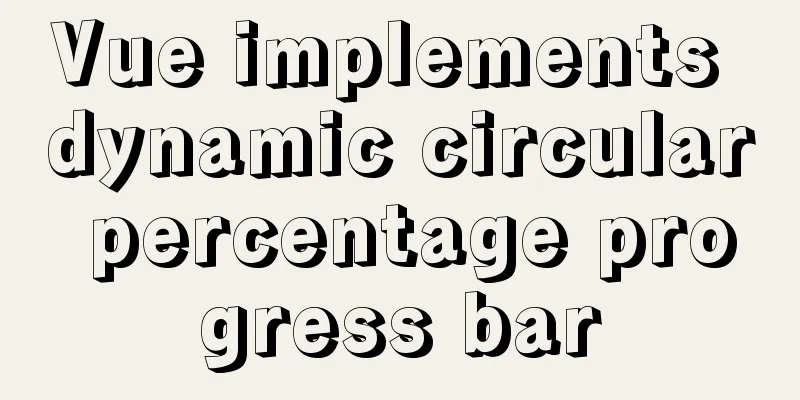Vue implements dynamic circular percentage progress bar

|
Recently, when developing a small program, I encountered a requirement to implement a circular percentage progress bar, similar to the following design diagram:
As a newbie, I felt that it would be difficult to implement, so I went to Baidu to see how others did it, but I didn’t find a satisfactory one. Either it was a static implementation, or it required a lot of DOM operations. It is better to avoid direct DOM operations in mini programs. The following is a dynamic implementation I made in the form of a Vue component. Here is the effect diagram first: Effect
Implementation stepsDraw a pie chart .pie {
display: inline-block;
position: relative;
width: 150px;
height: 150px;
margin-top: 40px;
border-radius: 50%;
background: #ccc;
background-image: linear-gradient(to right, transparent 50%, #4479FD 0);
color: transparent;
text-align: center;
}Achieve proportion effect This is achieved by adding pseudo-element occlusion and movement. The code is as follows: .pie::before {
content: '';
position: absolute;
top: 0; left: 50%;
width: 50%; height: 100%;
border-radius: 0 100% 100% 0 / 50%;
background-color: inherit;
transform-origin: left;
animation: spin 5s linear infinite, bg 10s step-end infinite;
}
@keyframes spin {
to { transform: rotate(.5turn); }
}
@keyframes bg {
50% { background: #4479FD; }
}
Using the CSS animation delay property Change the animation time above to 50, 100 respectively, so that you can directly pass the corresponding delay seconds in animation-delay , for example, -60s will be displayed at 60% animation-play-state: paused; animation-delay: -60s; Achieving a torus shape Add a positioned div directly in the div <div class="pie">
<div class="pie-inner">
{{num}}%
</div>
</div>Add a constant speed animation startAnimate (step, limit, speed) {
setTimeout(() => {
// num is a percentage if (this.num < limit) {
this.num += step
this.startAnimate(step, limit, speed)
} else {
this.num = limit
}
}, speed)
}Bind calculated properties to animation-delay Convert num into corresponding delay seconds in real time computed: {
delay () {
return `-${this.num}s`
}
}SummarizeSo far, a dynamic circular percentage progress bar has been basically realized, but it is not perfect yet. If you have any comments or questions, please feel free to raise them. The above is the full content of this article. I hope it will be helpful for everyone’s study. I also hope that everyone will support 123WORDPRESS.COM. You may also be interested in:
|
<<: Mysql command line mode access operation mysql database operation
>>: Analysis of the Principle and Method of Implementing Linux Disk Partition
Recommend
About Nginx gzip configuration
The principle of nginx to achieve resource compre...
Summary of @ usage in CSS (with examples and explanations)
An at-rule is a declaration that provides instruc...
Solve the problem of yum installation error Protected multilib versions
Today, when installing nginx on the cloud server,...
Analysis of the Principle of MySQL Index Length Limit
This article mainly introduces the analysis of th...
Why MySQL should avoid large transactions and how to solve them
What is a big deal? Transactions that run for a l...
Detailed explanation of MYSQL database table structure optimization method
This article uses an example to illustrate the me...
Analysis on how to solve the problem of Navicat Premium connecting to MySQL 8.0 and reporting error "1251"
If people have been idle for too long, they will ...
How to deploy services in Windows Server 2016 (Graphic Tutorial)
introduction Sometimes, if there are a large numb...
Eight hook functions in the Vue life cycle camera
Table of contents 1. beforeCreate and created fun...
How to create your first React page
Table of contents What is Rract? background React...
Tips on HTML formatting and long files for web design
<br />Related articles: 9 practical suggesti...
CSS scroll bar style modification code
CSS scroll bar style modification code .scroll::-...
Simple operation of installing vi command in docker container
When using a docker container, sometimes vim is n...
HTML solves the problem of invalid table width setting
If you set the table-layer:fixed style for a tabl...
Using streaming queries in MySQL to avoid data OOM
Table of contents 1. Introduction 2. JDBC impleme...












